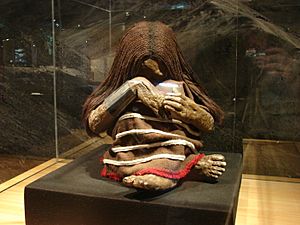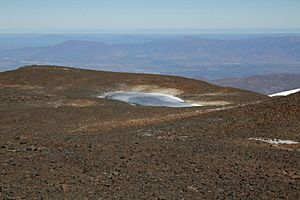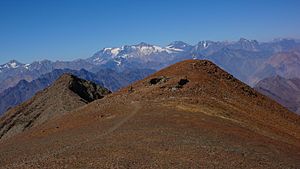Plomo Mummy facts for kids
The Plomo Mummy is the incredibly well-preserved body of an Inca child. It was found on Cerro El Plomo mountain near Santiago, Chile in 1954. This discovery was made by Guillermo Chacón Carrasco, Jaime Ríos Abarca, and Luis Gerardo Ríos Barrueto.
The mummy was brought to the attention of Grete Mostny at the Chilean National Museum of Natural History. She helped the museum get the mummy. The Plomo Mummy was the first important discovery of a frozen mummy from an Inca ritual. This ritual was called qhapaq hucha, which means a special child sacrifice at high altitudes.
The real mummy was on display until 1982. Then, experts decided it was better to replace it with a copy to keep it safe. The original mummy is now cared for by the National Museum of Natural History in Santiago, Chile. The replica is what visitors can see today.
Contents
How the Mummy Was Buried
The El Plomo mummy was kept in excellent condition by the cold, dry air high up in the mountains. It was found in a pit about 1 meter (3 feet) deep. A stone slab covered the pit, which was part of several small stone structures.
The child was found sitting with his knees hugged close to his body. He was part of a special Inca ritual. He was likely buried alive as part of this ceremony. Some signs suggest he might have been given maize beer and coca leaves. These were used to make him feel numb before the ritual.
The boy was fully dressed in clothes made from alpaca or llama wool. He wore a black sleeveless tunic and a large grey shawl. His headdress was decorated with condor feathers. He also had unused leather moccasins on his feet and a headband to keep his hair neat. Two silver jewelry pieces, a heavy bracelet and an H-shaped pendant, showed he was from an important family.
Many special items were buried with the boy. These included small statues, a silver female idol with tiny clothes, and a llama made of gold. Another llama was made from a red shell. A small woven bag held coca leaves that still smelled fresh. There were also balls made from animal intestines. These balls contained human hair, fingernail clippings, and teeth. These objects, along with the child's sacrifice, were meant to please mountain gods. People believed this would prevent disasters, bring good weather, or help with other religious events.
Finding the Mummy
On February 1, 1954, a group of climbers found the mummified body of a child. This happened at the top of El Plomo mountain, about 5,400 meters (17,716 feet) high. The mountain is in the Andes mountain range near Santiago, Chile.
The climbers were Guillermo Chacón Carrasco, Luis Gerardo Ríos Barrueto, and Jaime Ríos Abarca. They were mule drivers who went on an expedition. They hoped to find old artifacts and ritual items to sell. When they reached the peak, they found a special ceremonial area with four stone structures. Under one of these, they found the mummy's tomb and the items buried with it.
They took the buried items but moved the frozen body to another cave. Then they went back to Puente Alto with what they had found. A few weeks later, they went to Santiago to try and sell the artifacts to the Museo Nacional de Historia Natural. On February 16, 1954, one of the men told Dr. Grete Mostny about the discovery. She was the Head of Anthropology at the museum. Dr. Mostny and the men agreed on a price, and the mummy was given to the museum.
Experts later found that the mummy was an Inca boy. He was about eight years old when he was part of the Capacocha ritual. The mummy was named "La Momia del Cerro el Plomo" after the mountain where he was found. His body was very well preserved. Scientists studied him before he was put on display in a special freezer at the museum. The mummy was found fully clothed and sitting with his arms around his knees. His hair was carefully braided into over 200 braids and held back by a headband made of human hair. His face had red and ochre stripes painted on it.
Today, a copy of the mummy is shown to the public. This helps to protect the real mummy. The original El Plomo mummy is still kept at the Chilean National Museum of Natural History. It is in a special room with controlled humidity and temperature.
Scientific Studies of the Mummy
The mummy was amazingly well preserved. This was thanks to the high altitude, cold temperatures, and dry air. Inca Capacocha sacrifices have special features that help scientists identify them. These include being found at high altitudes, usually involving children, and having specific items buried with them.
Scientists believe the boy was buried alive. For Capacocha rituals, the Incas would give the chosen child chicha, an alcoholic drink, and coca leaves. These were meant to make the child feel numb. The boy was found wrapped in a tunic made of llama wool, trimmed with llama fur.
When the mummy was first found in 1954, only a few studies could be done. This was because of the limited technology at the time. Scientists took X-ray images to look at the mummy's bones. They also analyzed ancient waste (called coprolite) found with him.
In 1982, after the mummy had been on display, small cracks appeared in the outer skin (epidermis) of one of its hands. Experts from UNESCO were asked to help. A six-week study was done on the mummy to learn more. New X-ray images were taken. Dental and bone studies showed the boy was about eight years old when he died. His bones showed no signs of injury, and his organs were still whole. The outer skin was hard, but the layers underneath were still soft. Scientists decided not to take a sample of the organs. This was to protect the mummy from tiny living things that could damage it. Electron microscope studies on small bumps (called verrucae) on the boy's hand found viruses. These were the first viruses ever found on an ancient mummy.
In 2003, a third study was done. The Hospital Clínico de la Universidad de Chile created a 3D model of the mummy. They were also able to find out the mummy's blood type and study its DNA.
Images for kids
See also
 In Spanish: Niño del Cerro El Plomo para niños
In Spanish: Niño del Cerro El Plomo para niños







